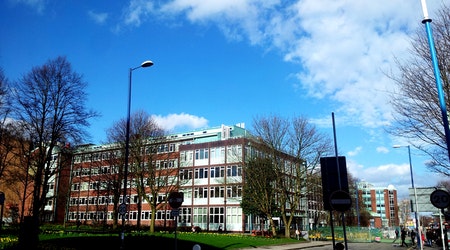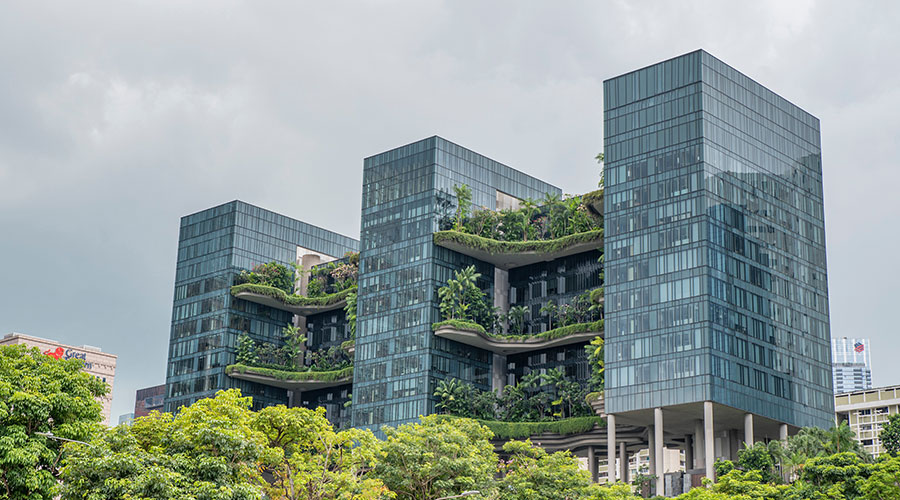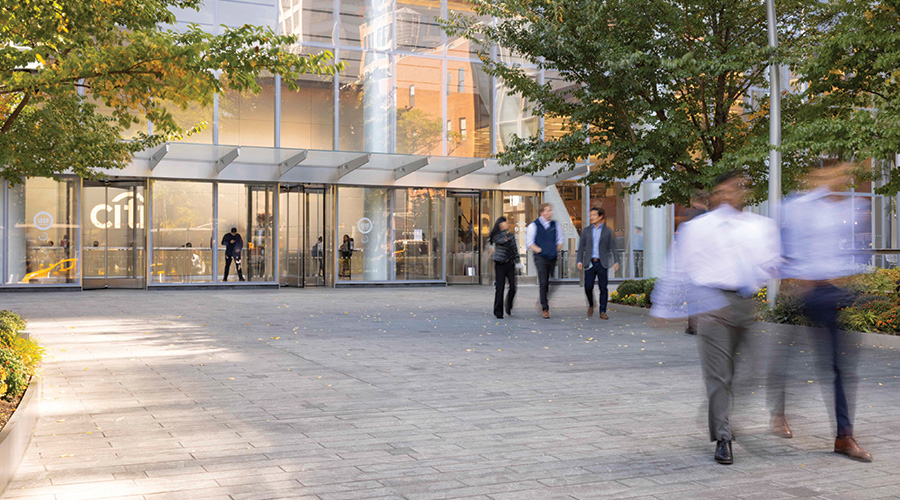Green Schools: Architecture as Pedagogy
Green or high-performance K-12 schools have long been lauded by green building advocates for producing higher test scores and reducing student absenteeism. These claims have been reinforced by recent studies, such as the Heschong Mahone Group study that concluded that students with the best daylighting in the study progressed 20 percent faster on math tests and 26 percent on reading tests in one year than students with the worst daylighting.
While it may be difficult to prove that sustainable design improves learning, green schools offer a more tangible benefit as well. Elements of green schools are doubling as teaching tools — both for traditional disciplines and to help students learn about environmental stewardship.
“Architecture as pedagogy is the next frontier in the evolution of high-performance schools,” says Robert Kobet, president of Sustainaissance International and chair of the committee developing the LEED for Schools application guidelines. “There are many examples of schools that have building features that are introduced in a cross-curriculum manner. These enhance the educational experience and raise the overall awareness of the students. The extent to which they are integrated is the hallmark of a high-performance green school.”
“Using the facility itself as a teaching tool is a significant benefit,” says Jo Cohen, senior project manager for Fletcher-Thompson Inc. “The possibilities are endless and curricula are being developed to incorporate environmental design into school instruction.”
There are numerous examples of how green design strategies can both contribute to an environmentally responsible facility and act as a way to study everything from geometry to physics.
Alternative energy strategies such as photovoltaic panels can be used to teach about electricity and how it is produced. If electricity use is monitored and that data is routed to computer labs by a building management system, students can perform statistical analysis and report the data to administrators. Light shelves can be used for geometry lessons, allowing students to measure the angle of reflection of sunlight as it enters the building. Daylight combined with a flagpole creates a sundial that can teach children about the earth’s rotation and the measurement of time. Building product selections, such as products with recycled content or renewable source materials, such as bamboo or rubber flooring, present opportunities to teach about global environmental issues and responsible resource consumption. Storm water retention ponds can be used to study biological ecosystems.
This is just a sampling of the possibilities. The important thing, though, is that when building a new school, designers and administrators decide early in the planning process which elements will be incorporated into the design and how those will fit into the curriculum.
“The design process should set the goal from the beginning that the school be a three-dimensional textbook,” says Kobet.
That means facility executives, principals, teachers and school administrators should be included in the design process.
“Buy-in of the critical players is essential,” says Kobet. “This may even include several individuals not normally associated with the planning process: local businesses, TV and radio stations, farmers, waste management services, etc.”
By including a wide variety of stakeholders, conclusions can be reached both on what green facility elements can be incorporated into the curriculum and what existing parts of the curriculum lend themselves to particular green design strategies. Just as the green design elements are simultaneously teaching tools and components of an environmentally responsible design, the curriculum will double as an engaging way to learn a traditional discipline and also a lesson in how buildings affect the environment — a lesson students often don’t get at a young age.
“To do this, you need an awareness of how school architecture as pedagogy can enhance and enrich the learning experience while satisfying all state educational requirements,” says Kobet. “You need an understanding of how to make the process integrative, not necessarily additive. Telling teachers they have to do more is not going to interest any but the most ardent and dedicated. But tell teachers that their teaching could be more interesting, more fun, and better noticed and appreciated and you may get someone’s attention.”
Educating teachers on the merits of a green building is the first step in teaching them how to teach in a green building. After that, the challenge is showing teachers how to use the elements of green design in their lessons.
“Teachers and principals have to learn how to teach in a green building,” says Lee Meyer, principal at KKE Architects. He says one example is learning how to optimize a classroom that uses daylighting strategies. “It’s important for teachers to learn how to teach in a classroom where lighting is from the sun, not from fluorescent bulbs. Teachers feel like it is their constitutional right to have so much illumination per square foot. Adjusting to changing light and the movement of the sun is the key.”
But once the teachers are acclimated to the healthy, high-performance school, the result is healthy, high-achieving students, says Kobet.
Cohen agrees: “Clean, healthy, quiet spaces suffused with natural light are ideal teaching environments.”
Even beyond the benefit to students, green schools can give the community an identity as environmental stewards.
“A true green school is cognizant of the ecological footprint of the school on the community and vice versa,” says Kobet. “Schools are icons that interact with and share in the cultural, financial, human and ecological resources of the community. With a green school, there reside numerous opportunities to enrich the educational experience while benefiting the community.”
Briefings
Sustainable San Francisco
San Francisco is the most sustainable U.S. city, according to SustainLane, an organization that collects, edits and publishes information about sustainable communities. The study was based on rankings in 12 categories, including air quality, LEED building, land use, energy/climate policy and agriculture.
The study was conducted among 25 U.S. cities with populations of more than 100,000. Each city was ranked 1 through 25 in each of the 12 areas, and then given a cumulative score.
San Francisco ranks first in solid waste, planning and energy, and ranks near the top in transportation, air quality and land use.
Following San Francisco as the most sustainable cities are Portland, Ore., Berkeley, Calif., Seattle, Santa Monica, Calif., Austin, Texas, New York City, Chicago and Oakland, Calif.
Energy Software
A Windows-based software program called FEDS (Federal Energy Decision System) allows users to input information about a building or buildings to assess energy consumption and predict future outcomes.
Available free to managers of federal facilities and state agencies, schools, state buildings, members of the Rebuild America partnership, and any other institution that receives funds from federal or state programs, the software can estimate energy consumption based on thousands of retrofit combinations.
Colored Green
A new Green Performance Standard for paints and coatings, developed by the Master Painters Institute (MPI), includes performance requirements in addition to environmentally responsible criteria, such as VOC limits and a banned chemical list.
The standard is designed to unify the environmental requirements of LEED 2.1 and 2.2, LEED Canada, the Ozone Transport Commission and the California Air Resources Board, while adding more stringent performance requirements.
“The patchwork of present environmental regulation is lacking in efficient uniformity,” says Barry Law, president of MPI. “Rarely, if ever, is product performance, durability or duty-cycle taken into consideration.”
MPI doesn’t test for VOC levels or banned ingredients but relies on manufacturers to provide it with data for its green certification.
A database of products that meet the new standard — GPS-1-05 — is available.
Applying LEED in Stores
The USGBC and LEED-NC for Retail Development Committee have completed the pilot version of the LEED-NC Application Guide for Retail (AGR). According to USGBC policy, the LEED-NC AGR will be tested and refined as necessary prior to official inception.
The LEED-NC AGR builds on the LEED-NC 2.1/2.2 rating systems in that selected prerequisites and credits have been modified to address design and construction decisions and opportunities specific to retail projects. The goal is to produce a LEED product that can be used to appropriately reward and recognize the incorporation of green design and construction strategies into retail projects.
Applying LEED in Schools
With a draft version scheduled to be released at November’s GreenBuild conference, the development of the LEED-NC Application Guide for Schools is nearing completion. The committee is hoping to include an additional six credits beyond LEED-NC, including credits focused on eliminating mold and providing good acoustic performance.
After the draft version is released, it will go through the traditional commentary period before it is released as a pilot program. The pilot is expected to be ready by mid-2006.
Survey Shows Public Backs Green
Ninety percent of Americans think that building more solar power facilities is a good idea, while 87 percent support expansion of windfarms, according to a national survey conducted by Global Strategy Group. The survey also found that 86 percent want increased funding for renewable energy research. The survey was conducted as a telephone interview of 1,000 adults.
“Americans are eager for a new energy policy,” the report notes, with 92 percent of Americans worried about dependence on foreign oil and 93 percent wanting government to develop new energy technologies and require the auto industry to make cars and trucks that get better gas mileage. The finding holds across all regions of the country and demographic groups, and the poll also reveals broad support for cleaning up air and water and a desire for more government involvement in environmental protection.
Ninety-two percent of respondent said dependence on imported oil was the issue of most concern, while global warming was a concern to 74 percent and climate change to 66 percent.
When asked about trust in sources of information about environmental issues, 83 percent of respondents indicated university scientists were the top choice, followed by U.S. Environmental Protection Agency (EPA) at 71 percent, Democrats in Congress at 57 percent, president George Bush at 52 percent, Republicans in Congress at 45 percent and business groups at 39 percent.
Tax credits to consumers who buy energy-efficient appliances was supported by 84 percent, while 81 percent supported development of hydrogen-powered cars, 81 percent support more hydroelectric facilities, 71 percent support the use of hydrogen fuel cell technology, 63 percent want more facilities that generate electricity by burning biomass, landfill gas and trash, 36 percent support more nuclear reactors and 33 percent want more coal-burning electric plants.
|
A Study in Sustainable Adaptive Reuse
Baltimore The 1.3-million-square-foot Montgomery Park Business Center was built in 1925 as a distribution warehouse to support Montgomery Ward Co.’s burgeoning catalog business. The eight-story building closed in 1985 when declining sales forced the company to discontinue its catalog business. It sat vacant until 1995, when developers purchased the building and began planning to convert it to office space.
In a request for proposals, the Maryland Department of the Environment — the building’s potential anchor tenant — required that the building be redeveloped to meet LEED standards. If so, MDE would lease 270,000 square feet. The developers agreed and the adaptive reuse was completed in 2003 for a cost of $80 million.
While that may seem like a hefty price tag, designers were actually able to keep costs down by keeping the building shell largely intact. The only major change was creating a new main entrance on the south side of the building, reorienting the building to handle parking and flow more conveniently. Additionally, the developers spent about $2 million removing lead-based paint, asbestos and other contaminants, as well as removing six underground storage tanks.
“Recycling” the building shell was one of several green strategies designers used. Even with 125,000-square-foot floorplates, large expanses of nearly floor-to-ceiling windows provide access to daylight for most occupants. The windows have low-e glass to limit heat gain, making the building more energy efficient. The old window glass was recycled as “glassphalt” and used for paving the parking lots. A rooftop ice storage system also helps reduce the amount of energy required to cool the building.
A 20,000-square-foot green roof was installed on the span between the two wings of the building. The roof helps reduce stormwater runoff. The building uses captured stormwater from the roof and parking lots as “gray” water for toilet flushes. Waterless urinals are also used throughout the building.
Software Company’s Corporate Headquarters Sets Silver Standard
Spartanburg, S.C. The six-story, 110,000-square-foot corporate headquarters for QS/1 Data Systems in Spartanburg, S.C. was shaped throughout by LEED criteria.
According to Spartanburg Mayor Bill Barnet, the building will serve as the cornerstone for resurgent investment in the downtown core.
QS/1 management’s goals for the building were a quality working environment within an affordable budget. Value-engineered design and specifications initially brought a guaranteed maximum price of $98 per square foot, allowing the owner the flexibility to increase square footage and add amenities. The finished building cost $105 per square foot, a figure within the company’s price range.
After an introduction to LEED, QS/1 management realized they could meet their primary objectives for the building by following LEED requirements, says Bill Cobb, president and CEO of QS/1. “It wasn’t difficult to make a case to build an environmentally friendly building,” he says. “It made real sense because we spend a huge percentage of our lives here every day.”
The facility includes an energy-conserving building envelope and high-efficiency HVAC, lighting and plumbing systems. Features that reduced the project’s environmental impact range from the redeveloped site itself with access to alternative transportation, to the stormwater capture system that irrigates the building’s generous landscaping, to the below-grade parking provisions that reduce the heat island effect.
The high-efficiency HVAC design combines gas-fired boiler heat with a chilled water plant for the chlorine-free air-conditioning systems. Variable-air-volume distribution carbon dioxide sensors trigger demand-controlled fresh air ventilation interfaced with an innovative variable speed energy recovery unit and an energy management control system. These systems help the building reduce energy by 30 percent compared with ASHRAE 90.1.
QS/1, which received a Silver certification with 33 points, is only the third LEED-certified building in South Carolina.
U.S. Green Building Council |
Chair
Kevin Hydes
Keen Engineering
Vice Chair
Tom Paladino
Paladino & Co.
Vice Chair
Zaida Hagar
City of Dallas
|
Secretary
Gail Vittori
Center for Maximum Potential Building Systems
Treasurer
James Goldman
Turner Construction Co.
Immediate Past Chair
James E. Hartzfeld
Interface Americas
|
Founder
David A. Gottfried
WorldBuild Technology Inc.
Founder
Michael L. Italiano
Sustainable Products Corp.
President, CEO and Founding Chairman
S. Richard Fedrizzi
U.S. Green Building Council
1015 18th St., NW Ste. 805
Washington, DC 20036
202/828-7422
|
Web site:
www.usgbc.org
e-mail:
info@usgbc.org
Related Topics:












